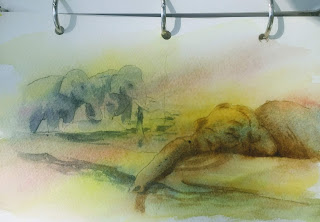WHY USE A JOURNAL?
Artist use journals/sketchbooks for lots of reasons. Some fill them with memories of places and people. Some use them to record ideas for future paintings. Some may dedicate a journal for one special reason, such as doing the July Watercolor a Day challenge. Just plain doodling is a great way to unleash creativity. In the next blog session, I'll explain another good reason for a journal: documenting all the steps taken to create a larger painting, from thumbnail sketch, to value study, to color studies, and all the way to finished piece.
Since I am traveling soon, I have been very interested in how to pack my art supplies, and should I bring a journal with me? In the past, if flying, I have just brought watercolor paper, some watercolor pencils, and a small brush. They fit just great in my carry-on, not adding much weight or space. But I miss the feel of watercolor.
So I started investigating journal reviews. I got a few to try out. I hope having me do the homework helps you decide what you want in a sketchbook/journal.
I created a checklist (which doesn't translate well in a blog) which I'll summarize here. The things I look for may not be the same as what are important to you. What I look for are:
SIZE OF JOURNAL/WEIGHT
COST
SPIRAL BOUND OR HARD BOUND?
Some prefer hard so that when open, it's like having a larger sheet of paper.
Some, like me, prefer the spiral because it's so easy to flip over and not let the binding get in the way of my hand (I'm left-handed)
PAPER TYPE (100% cotton, pulp, etc);
PAPER SIZE (140 lb, 90 lb)
PAPER TEXTURE
ARE BOTH SIDES SAME?
DOES IT GLAZE WELL?
DOES IT LIFT?
DOES IT GIVE SMOOTH WASHES AND BLENDS?
IS IT GOOD FOR PEN/INK?
DOES IT WARP?
DOES IT BLEED THROUGH TO THE OTHER SIDE?
IS IT GOOD FOR DRAWING?
PERKS: elastic to hold it shut; pockets in the back; pen holder; etc.
SO HOW DID SOME SKETCHBOOK BRANDS HOLD UP?
Here are three that I tried out. Left to right, top to bottom are:
Handbook Journal Company 5 1/4 by 8 1/4; Handmade sketchbook my daughter made me; Stillman & Birn 7 x 10 Beta Series for mixed media; Winsor Newton Watercolor Aqua 5 x 7.
Here are my first attempts with each one, in the same order. The one my daughter made me is strictly for sketches and dry media only. The paper is good, but made for drawing and is about 70 pound weight.
Next pages, the back of the other pictures.
Except for the sketchbook, I tried each with several media and wet techniques: wet in wet, pen and ink, washes, lifting, glazing, Posca Pens, watercolor pencils, and pencil.
The Handbook Journal : Cost about $12. 60 pages, about 95 lb. It was made with pulp, not cotton rag, and was bound and sewn. That is for people who prefer to be able to paint more of a scene in landscape mode. It did fair with washes and well with lifting. Glazing was poor to fair. Pen and ink was great because of the smooth finish, as were watercolor pencil and graphite pencil. Blending of color was poor though.
I liked the size of the Handbook Journal. It's very light and has an elastic closure. I would use it for pen, ink, pencil, watercolor pencil, and only very light watercolor.
Stillman and Birn: This journal was recommended by at least three traveling artists in Watercolor Artist Magazine, August 2018. So I tried. The paper was heavy weight, 140 lb, cold press, but it was pulp, not cotton. Size was 7 x 10, and cost was $19. It had 50 pages, and all together weighs about a pound. It is spiral bound--good for me--and was only fair with washes and glazing. It was great for lifting, pen and ink, watercolor pencil, and pencil. Both sides of the paper seem about the same, and are very smooth. (Not quite like hot press) There was very little warping after the paper dried. And I liked that nothing bled from one side of the paper to the other, not even the Posca Pens, which are a type of acrylic paint in the pens. And it took several erasures without destroying the paper.
Winsor Newton WC Aqua: This was my favorite of all of them. It was 5 x 7, ost about $12, and only has 15 pages. But the paper is 100% cotton!! It is spiral bound, does well with washes, lifting, glazing, pen and ink, wc pencil, pencil, and blending. It's a little rough with pencil. There is no bleeding from one side of the paper to the other. And both back and front of each page are the same texture. You can use this with heavy applications of water and it will behave as well as your good paper will. I wish it came in a slightly larger size.
What would I like to try in the future? Two stand out in my mind: Kilimanjaro from Cheap Joe's and Khadi, which I believe is made in Singapore. Both are made from 100% cotton rag. The Kilimanjaro comes in several sizes and has 70 pound drawing paper between each piece of watercolor paper. That is great for two reasons. One is that it protects your painting from pencil or paint or other materials that might be on the page before it. Second, I really like the idea of having drawing paper and painting paper in the same sketchbook.
Next up: How I put together my own personalized journal.






































